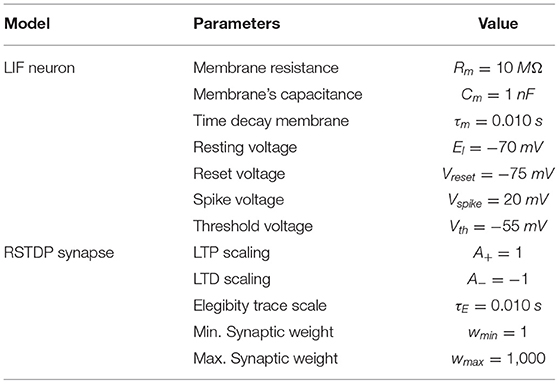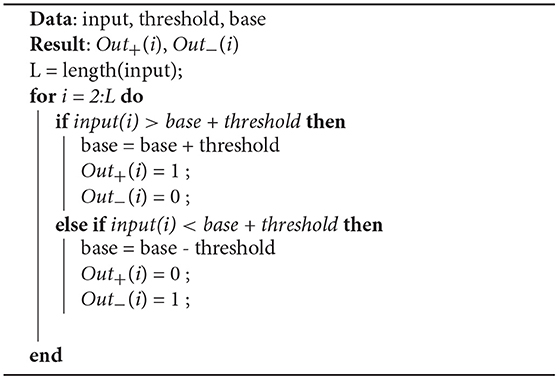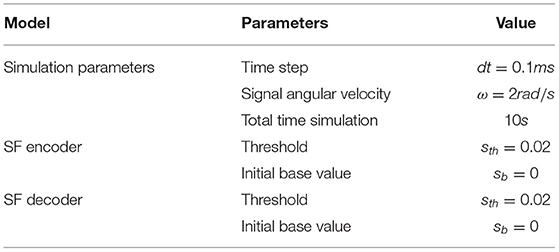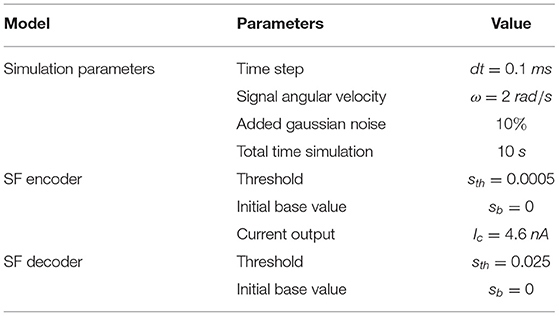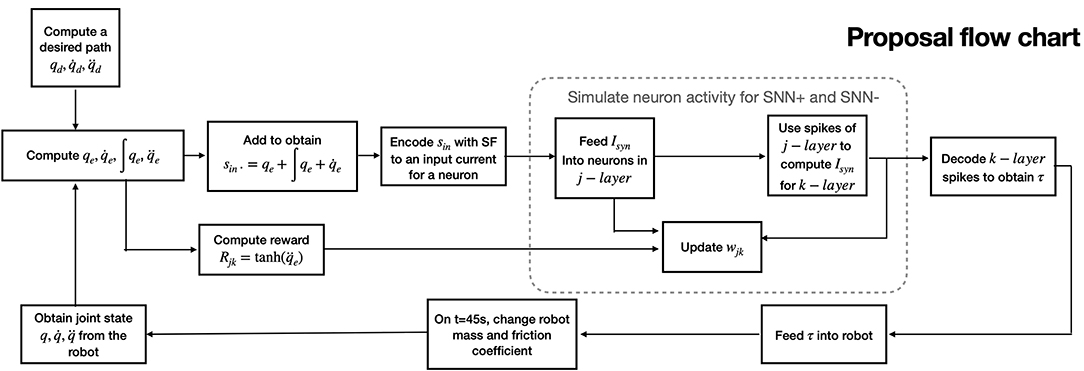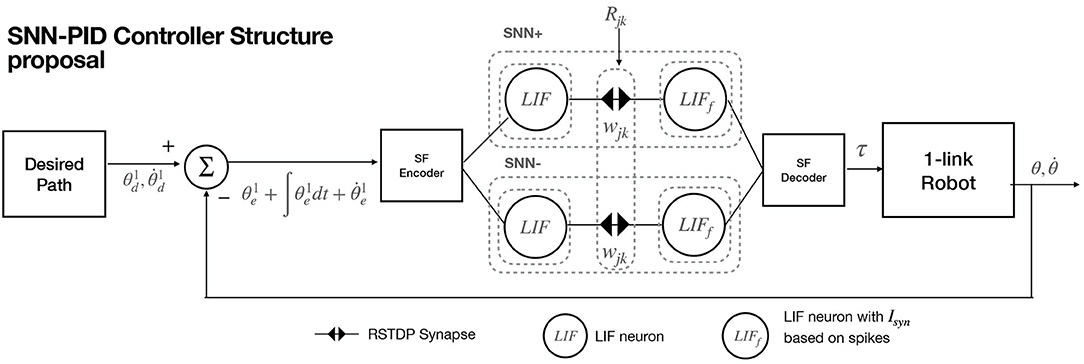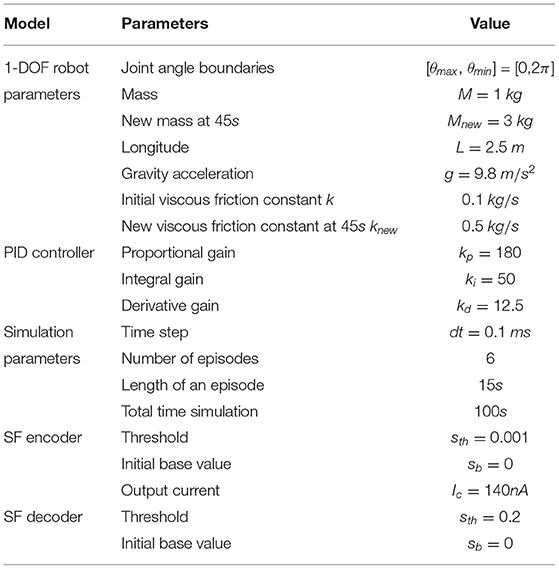- Instituto Politécnico Nacional, Centro de Investigación en Computación, Mexico City, México
Neuromorphic computing is a recent class of brain-inspired high-performance computer platforms and algorithms involving biologically-inspired models adopting hardware implementation in integrated circuits. The neuromorphic computing applications have provoked the rise of highly connected neurons and synapses in analog circuit systems that can be used to solve today's challenging machine learning problems. In conjunction with biologically plausible learning rules, such as the Hebbian learning and memristive devices, biologically-inspired spiking neural networks are considered the next-generation neuromorphic hardware construction blocks that will enable the deployment of new analog in situ learning capable and energetic efficient brain-like devices. These features are envisioned for modern mobile robotic implementations, currently challenging to overcome the pervasive von Neumann computer architecture. This study proposes a new neural architecture using the spike-time-dependent plasticity learning method and step-forward encoding algorithm for a self tuning neural control of motion in a joint robotic arm subjected to dynamic modifications. Simulations were conducted to demonstrate the proposed neural architecture's feasibility as the network successfully compensates for changing dynamics at each simulation run.
1. Introduction
Spiking neural networks (SNNs), also called the third generation of neural networks, represent a new design paradigm where some biological neural dynamics are replicated, with similar energy efficiency and in situ learning capabilities, as seen in living organisms, whereas hardware miniaturization is feasible. Neuromorphic computing (Saxena et al., 2018; Kendall and Kumar, 2020) emerges as an effort to create built-in neural hardware, emulating the neuronal impulsive-like electrical activity and in-situ synaptic learning in analog devices. Therefore, neuron dynamics have to be translated into circuit proposals to achieve these behaviors. As for the synapses, where learning occurs in biological brains, memristors are taking their role as the electrical element counterpart (Zhang et al., 2021). These devices, theorized by Leon Chua, relate flux with charge, resulting in a variable resistor. The conductivity is given by how much current has flowed between its ports in a determined period. Therefore, its conductance serves as the synaptic weight which can be tuned by applying current (Yue and Parker, 2019). At Zamarreño-Ramos et al. (2011), an exploration into how neurons and memristors can be interconnected as an array scheme to achieve large scale spiking systems, using synaptic time-dependant plasticity (STDP), is presented. Since then, several proposals have been presented. Recently, a memristor analog crossbar circuit is used to emulate a single layer perceptron for the MNIST image classification problem (Kim et al., 2021). In Shi et al. (2021), a circuit proposed to manage reward modulation is presented, setting the building blocks for implementation.
Cutting-edge neuromorphic implementations still demand going deeper into studying the neuron dynamics and plausible learning methods since the non-differentiable nature of the neuron dynamic doesn't allow the use of the well-known backpropagation synaptic weight adjustment; widely employed in ordinary artificial neural networks (ANN). Therefore, there are some open challenges to address before constructing high-performance neuromorphic devices, as well as encoding and decoding information techniques. According to Hu et al. (2022), learning algorithms used in SNNs are summarized in:
• Modified gradient-descendent-based algorithms: As neuron models are non-differentiable, some modifications are pertinent to achieve the classical backpropagation learning rule, employed in most of the ANNs, i.e., SpikeProp (Kheradpisheh and Masquelier, 2020).
• Algorithms using a spike train kernel: Where an error function is used to compute and update synaptic weights, using a spike train kernel, i.e., SPAN (Mohemmed et al., 2012).
• Algorithms using synaptic plasticity: Based on Hebbian learning, the synaptic weights tuning is given by the correlation of pre and post-synaptic spikes. In STDP, the modification of the neural strength connections is performed as the learning process occurs, as in biological brains (Hao et al., 2020).
Synaptic plasticity phenomena explain how learning is conducted in biological brains, enhancing conductivity between neurons that fire together, wire together, and deprecating those unused connections.
On other hand, information, usually shaped as an analog signal, has to be encoded into the neuron spike domain. The scientific community is still debating how information from the environment is converted into electrical neural activity. According to Dupeyroux et al. (2021), neuron spike coding methods can be classified into three categories.
• Population encoding: A group of n neurons, each one with different characterization (i.e., different τm, Rm, Cm), is set to be excited about an input current. As a result, at a given time-step, some neurons will spike faster than others. The characterization of neurons is made in such a way the domain of the input signal is distributed between the n neurons, using tuning curves (Voelker and Eliasmith, 2020).
• Rate-based encoding: One neuron is used to encode the variation of the input signal ∈ [Imin, Imax]. As larger an input signal gets, the spiking frequency of the neuron increases. A minimal input current traduces into a minimum spike frequency, inside a frequency interval ∈ [fmin, fmax].
• Temporal encoding: Also called pulse coding, produces spikes according to a temporal change of the input signal. This is, if an input signal is constant, no spikes are produced, even if the signal is large. As soon the signal increases or decreases, spikes will be emitted.
While population encoding reaches the best performance, its efficiency is reduced, as it needs a huge amount of resources (neurons) in order to be implemented. Rate-based encoding has become the standard, but it presents the need to spike even with a zero input signal, increasing the power consumption. Besides, it can't encode negative values, as seen in Bing et al. (2019a), where a negative input signal has to be fed as its absolute value. The temporal encoding provides a time-based method, providing more information capacity per synaptic event, and it is supported by neurophysiological studies in auditory and visual processing in the brain (Guo et al., 2021). SNNs can send data encoded as the timing of spikes occurrences, allowing fast and low energy consumption hardware implementation, applicable to real-world robotics problems. Furthermore, SNNs are more prominent than non-spiking ANN as they profit from temporal stimulus information, referring to the precise timing of events that allows obtaining and processing of information.
Spiking neural networks on robotic design systems are a promising research topic as online learning, and huge computational capacities are commonly required in this field. For instance, at Chen et al. (2020), an SNN controls a 4-DOF (Degree of Freedom) manipulator arm using population encoding and a proposed learning rule. Bing et al. (2019b) use a reward-modulation learning rule to teach a differential robot how to track a path, using rate-based encoding to do conversion of visual input into spiking activity. A similar task is studied numerically by Bing et al. (2019b), controlling a snake's movement instead. Lu et al. (2021) achieve obstacle avoidance for an Ackerman-type mobile robot, using two neurons and two synapses, implemented on a digital development board. Bing et al. (2019a) achieve obstacle avoidance and goal-reaching for a differential robot, implementing separate neural control structures for each task. Over these articles, while control is achieved based on interaction with the environment, changing dynamics in the robot produced by weathering in the joints or unknown environmental perturbances are not addressed. A typical control strategy for a robotic open-chain manipulator requires re-tuning each time friction or mass on the robot changes, affecting performance. This article proposes an SNN architecture that learns how to reconstruct an input signal. Inspired by control theory, this structure is then used in a control loop, using the same input signals in a PID, but fed into the structure in order for the synaptic weights to evolve over changing dynamics on a 1-DOF robotic arm.
The document is structured as follows: Section 2 describes the control problem to be tackled, neuron and synapse dynamics, and how these are ensembled for a controlling proposal. Section 3 shows the simulation results of the proposed SNN implemented in 1-link. Section 4 discusses results, advantages, and drawbacks, while at last, Section 5 is devoted to conclusion and future study.
2. Materials and Methods
2.1. Control Problematic
According to Craig (1986); Lynch (2017), the dynamics of an open chain robotic manipulator can be written in joint space as:
Where are the joint angles of the robotic arm with n DOFs, M(·) stands for inertia matrix terms, C(·) is the Coriolis's matrix and friction dynamics, g(·) are gravity compensation terms and τ = [τ1, τ2, ..., τn]T means the torque control for each joint. Typically, PID control strategies are the standard. Based on the desired state xd(t), a tracking error qe = qd − q is defined, setting the control input τ(t) as:
At Equation (2), are the gain matrix for proportional, derivative, and integral control, which elements are zeros except in the diagonal. This strategy is the function of the tracking error, which on zero, there will be no control output. Consider:
Here, represents our model representation of the plant, and it is perfect if , , and . Therefore, if the control loop works on the estimation, it would work for the real model. Usually, in the development process of a robot controller, Kp, Ki, and Kd are tuned for initial , and . This becomes a problem as the robot's weathering modifies its dynamic properties, such as friction. Or perhaps, mass changes over time, as seen in biological limbs in living creatures.
2.2. Spiking Neural Network Modeling
In order to describe the proposed structure, a review of how a neuron generates spikes, how synapses store learning, and how to generate reward signals is presented.
2.2.1. Neuron Modeling
As an input stimulus is provided to the neuron cell, shaped as an input current, the membrane's potential vm increases. Once it overpasses a threshold voltage vth, the neuron produces a spike, and then it immediately resets its membrane potential to a reset voltage vreset. The neuron cannot fire again until a certain refractory period has elapsed. Some differential equation models illustrate these neural dynamics with high biological plausibility but prohibitive computational cost such as Hodgin and Huxley or Izhikevich models (Izhikevich, 2004; Valadez-Godínez et al., 2020). Nonetheless, others with a lesser plausibility can compute the membrane potential with less effort degrading the accuracy, but are still useful as a good model approximation, due that spikes generation with the same characteristics as biological neurons might not be necessary for circuit implementations, such as the Leaky Integrate and Fire (LIF) (Lu et al., 2021) model, given by:
At Equation (4), vm(t) represents the neuron's membrane potential, El is the resting potential of the neuron, Rm membrane resistance, τm = RmCm is the decay time for vm(t), being Cm the neuron's membrane capacitance. Isyn stands for the injected current to the neuron. Each time a spike arrives at the neuron, Isyn increases. On the other hand, if no spikes arrive at the neuron, the current decays. This phenomenon is described by LIF conductance-based model (Hao et al., 2020; Lu et al., 2021), composed of Equations (4 and 5):
In Equation (5), wij is the synapse strength value between a presynaptic, i − th, neuron and a postsynaptic, j − th, neuron. As for each postsynaptic neuron, there can be N presynaptic neurons connected, is then a vector with firing times from each of the N presynaptic neurons. δ is the Kronedecker delta function, which δ(x) = 1 for x = 0 and δ(x) = 0 for x≠0. Equation (5) assumes all presynaptic spikes have been produced at time t. For each time a new spike happens, , therefore, . Once the neuron threshold voltage vth is over-passed, the neuron spikes, emitting a pulse of magnitude vspike, then, the neuron resets to a reset potential v = vreset and it starts integrating again. Figure 1A shows the LIF structure model, while its spiking activity for a given fixed and variable input current is shown at Figures 1B,C, respectively.
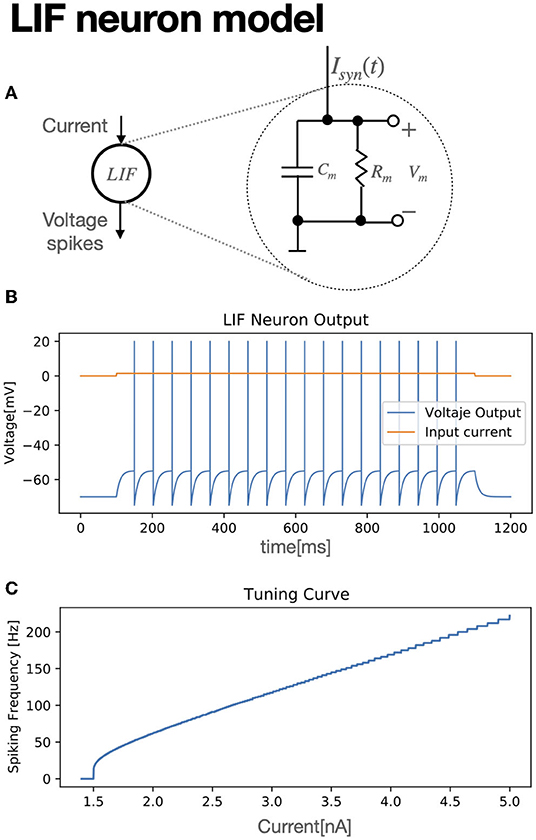
Figure 1. LIF model (A) diagram of a spiking LIF neuron. (B) Spiking activity for a LIF neuron with Isyn = 1.51 nA. (C) Tuning curve of the neuron model. Neuron parameters are in Table 1.
2.2.2. Synaptic Modeling
Once we define how neurons produce spikes, we will expose how synaptic strength is adjusted. STDP (Bing et al., 2019b) is an unsupervised learning algorithm (based on the Hebbian learning rule) for SNN. It describes how synaptic weights are strengthened or weakened according to neural spike activity, and it has demonstrated plausibility over conducted experiments in biological systems. First, a synaptic weight value is randomly assigned for each defined synapse. Then, the time difference between pre and post-synaptic firing times Δt = tpost − tpre is computed and it determines the rate of change Δw on the synaptic weight w as:
Here, A+, A− are scaling constants depicting whether our synaptic weight has been incremented (Long Term Potentiation LTP) or decremented (Long Term Depression LTD). τpre, τpost are positive and negative constants representing decay time. Once again, these equations imply all spikes have been produced. Since neurons do not have a memory of all their fired spikes (Bing et al., 2019a), Equation (6) can be rewritten in the function of the last firing time (Morrison et al., 2008; Gerstner et al., 2018). This results in the following expressions:
As each time a presynaptic spike tpre is produced, tpre = t and δ(t − tpre) = 1. With each postsynaptic spike, tpost = t and δ(t − tpost) = 1. Next, we define an eligibility trace Ejk for each synapse between a presynaptic neuron j and a post-synaptic neuron k as:
This expression computes synaptic weight changing history, generated by the collected spikes. To control the sensitivity of the plasticity to delayed reward, an exponential τE = τpre = τpost constant for Ejk(t) is defined. This implies a symmetric learning rate for LTD and LTP (Taherkhani et al., 2020). Change in synaptic weights is obtained by integrating (Equation 9). The reward modulated STDP, or R-STDP learning rule model, integrates the reinforcement learning paradigm in SNNs, modifying the STDP algorithm based on dopamine effects for learning in biological brains (Framaux and Gerstner, 2016). Consider:
Here, is a reward signal for the synapses between layer a j − th and k − th layer in a network, bounded inside [−1, 1], which enables or disables synaptic modification (called learning), and it is defined by interaction with the environment as a function of an objective (i.e., the desired path, desired position, desired action). It is worth mentioning that, when Rjk = 1, the R-STDP rule equals STDP, as Equation (7) equals Equation (10). When Rjk is equal to 0, learning is inhibited.
2.2.3. Encoding and Decoding Between Continuous and Spike Domains
Step forward encoding (SF henceforth), described in Kasabov et al. (2016) and Dupeyroux et al. (2021), is considered a temporal encoding algorithm, as it converts the variation of an input signal to spikes. The module for the step forward encoding contains two outputs ports Out+, Out−, and an input port, sin, which is compared with a baseline value sb. If the incoming signal is bigger than a certain predefined threshold value sth (this is: sin > sb + sth), then a spike will be produced over Out+. On the contrary, if the signal has decreased (sin < sb − sth), a spike will be produced in Out−. As the spike's domain is always positive, the emitted spikes can be processed by SNNs representing positive and negative changes in value. The procedure herein is shown in Algorithm 1.
A neural structure proposal for exploiting SF encoding with SNN and STDP is shown in Figure 2A. An input signal is fed to an encoder and the decoded output signal tends to match the original, as the synaptic weights get updated (Figure 2B). For signal growth, learning in the w+ synapse occurs. Once the signal decreases, an update for negative synapse w− begins (Figure 2C). In order to foster a quick synaptic weight adjustment in both synapses, Gaussian noise was added to the input signal sin (Figure 2D), with a SD of σ = 0.01. As a secondary effect, accumulation in the decoder's output signal takes place, as seen in Figure 2E. In order to harness the low-pass filter dynamics of the LIF neuron model, a slight modification is proposed. Instead of spikes, a given current Ic is sent as the encoder outputs. Figure 3 shows the same signal reconstruction obtained with the proposed modifications, setting Ic = 4.6nA as current input to a LIF neuron which, according to its tuning curve (refer to Figure 1C), it would produce spikes at a frequency of 200 Hz. Signal reconstruction is achieved. Moreover, Gaussian noise with σ = 0.3 is added to the input signal, achieving signal reconstruction and filtering, as seen in Figure 3D.
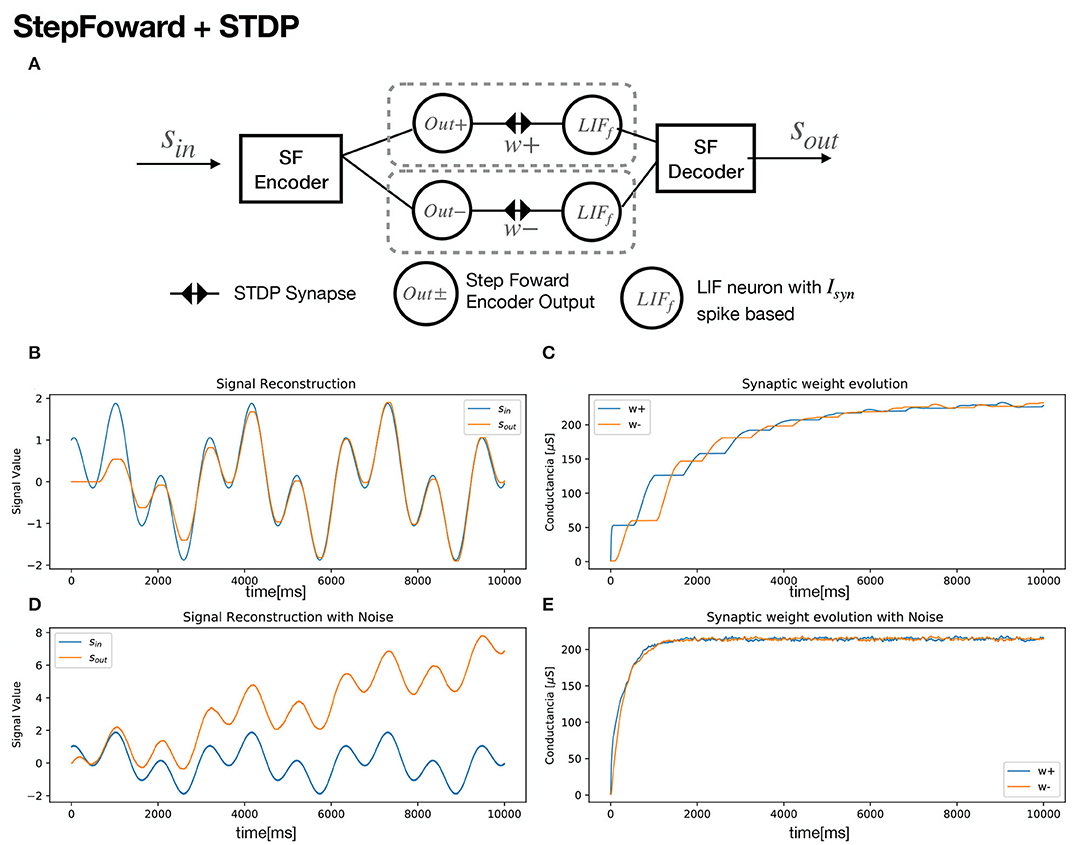
Figure 2. Step Forward + STDP Neural structure. (A) Schematic of the structure. (B) Sinusoidal Signal sin = sin(ωt) + cos(3ωt) being reconstructed. (C) Synaptic Weight evolution. (D) Gaussian noise with σ = 0.01 was added to foster synaptic update. (E) Synaptic Weight evolution with added noise. Simulation Parameters are available at Table 2.
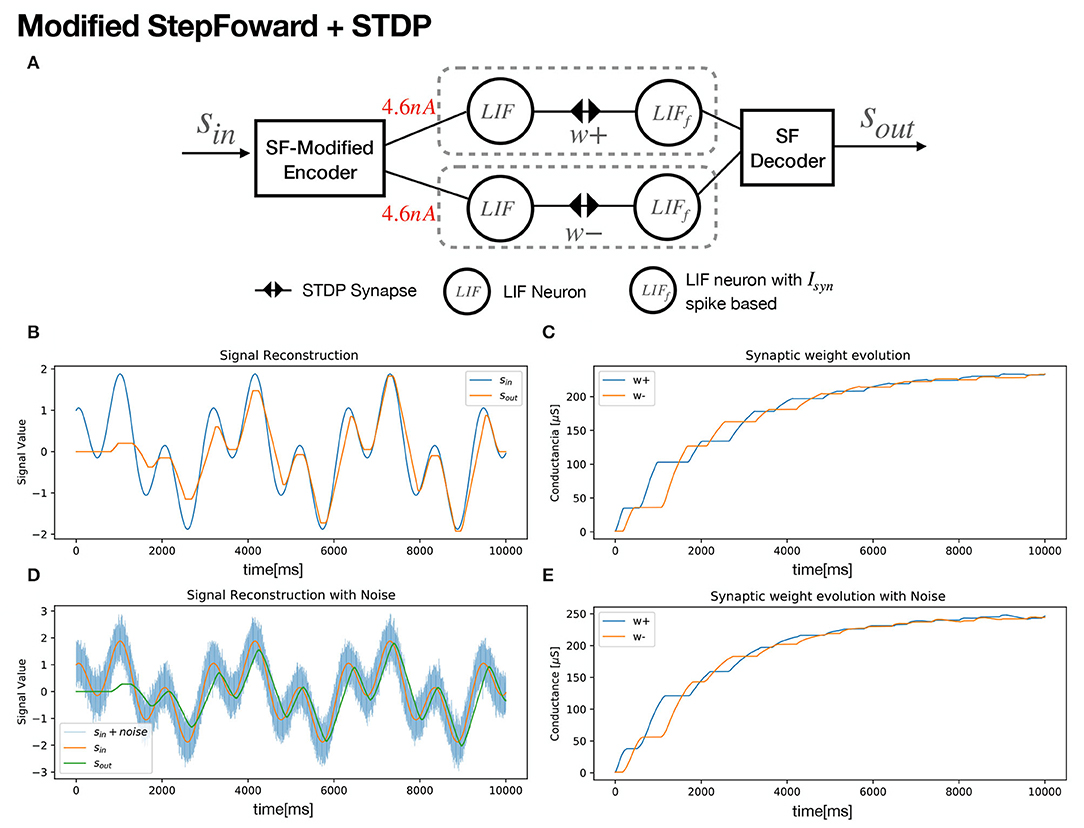
Figure 3. Modified Step Forward + STDP Neural structure. (A) Schematic of the structure. (B) Sinusoidal Signal sin = sin(ωt) + cos(3ωt) being reconstructed. (C) Synaptic Weight evolution. (D) Gaussian noise with σ = 0.3 was added to foster synaptic update. (E) Synaptic Weight evolution with added noise. Simulation parameters are available at Table 3.
2.3. Self Tuning SNN Controller Proposal
The objective is to create an SNN structure that enables the learning of the robot's dynamics and reconstructs the necessary torque control output based on Equation (2). In order to take advantage of synaptic plasticity properties, tuning PID control parameters K on the fly is performed. The procedure steps are shown in Figure 4 and described in detail upnext. First, a module computes the desired path, using a cubic polynomial trajectory planning generation Algorithm (Craig, 1986; Spong et al., 2005), with initial and final points randomly defined between the joint's boundaries, and initial and final desired velocities set to zero. Next, are computed and added; then, they are applied to an SF encoder module, which out is sent to an SNN processing positive changes (called SNN+), and another for negative changes (called SNN-). Both networks share the same structure, as SNN+ and SNN- are intended to process the necessary signal increments and decrements, respectively. These networks are composed of two layers j − th and k − th composed of n LIF neurons each (same amount of DOFs in the robot), modeled by Equations (4), (5). Between j − th and k − th layers, there are synapse matrices with randomly initialized weight values between minimum and maximum synaptic values [wmin, wmax]. For all synapses, its value will be modified accordingly to Equations (8–10). Each output spike from the neurons of the k − th layer in SNN+ and SNN- serves as input for the n SF decoders, which output corresponds to each torque input signal for the robot. The proposed structure is shown in Figure 5.
3. Results
3.1. 1-DOF SNN Simulation Implementation
For a 1-link robot (a pendulum), its non-linear model has a shape like in Equation (1) and is given by:
Where m stands for the arm's weight, l its length, g is the gravity acceleration term, k is the viscous friction in the joint, θ ∈ [θmax, θmin] is the joint angle, τ represents torque in the robot's joint, acting as the input control signal to the system.
Figure 6 shows simulation results comparing performance between three controllers:
• SNN-STDP: proposed model with fixed reward signal Rjk = 1.
• SNN-RSTDP: proposed model with reward signal Rjk given as a function of acceleration error .
• A manually tuned PID controller, tuned by the Ziegler Nichols technique (Ogata, 2010)
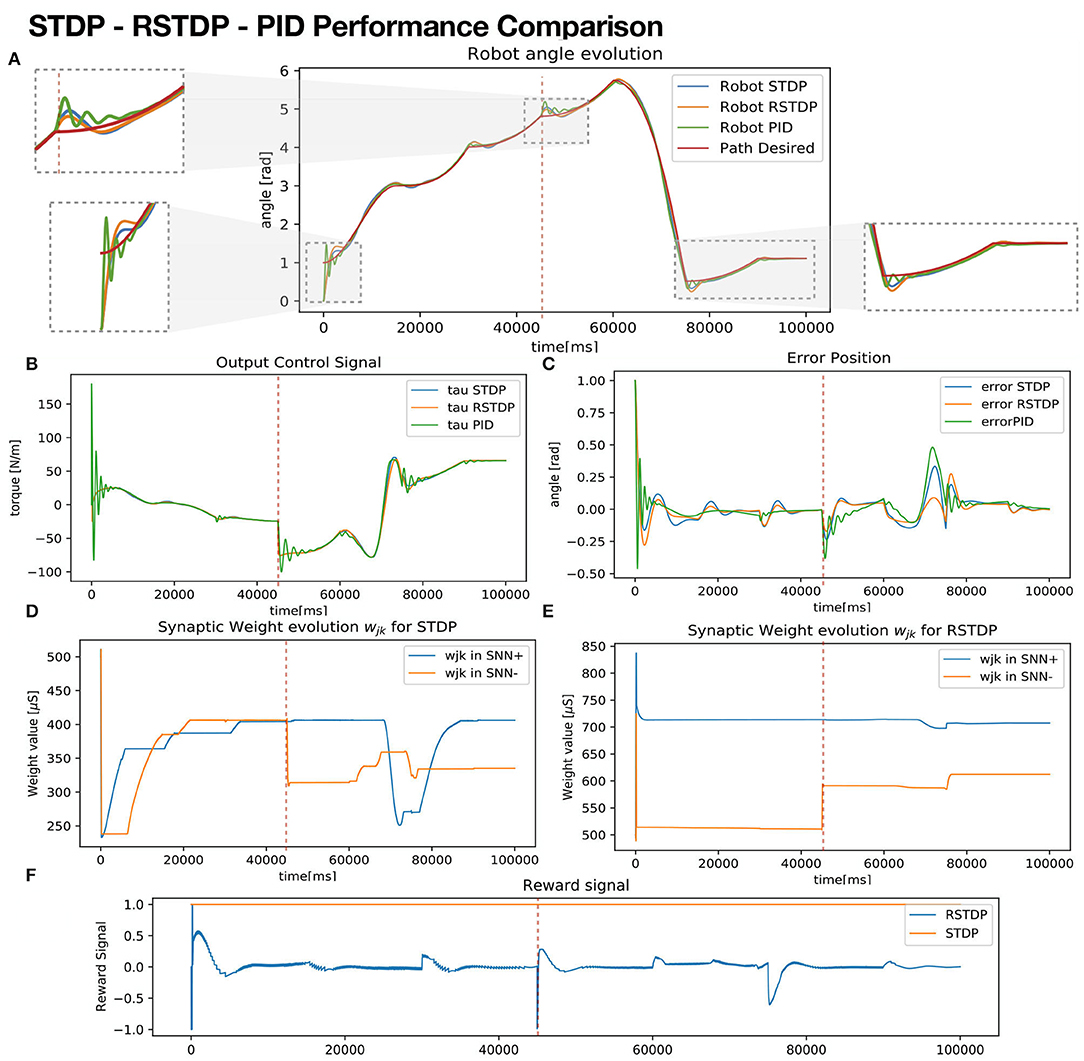
Figure 6. 1-Link robot controller performance comparison. (A) Robot Angle evolution for each robot, SNN-RSTDP: with (Yellow), SNN-STDP: proposal with Rjk = 1 (Blue), PID-Controller tuned with Ziegler Nichols (Green), compared against reference (Red). (B) Control output of each controller. (C) Error position: difference against the reference. (D) Synaptic weights evolution for constant reward robot (SNN-STDP). (E) Synaptic weight evolution for the rewarded robot (SNN-RSTDP). (F) Reward signal for both SNN proposals.
For the SNN-RSTDP controller, a bounded reward signal delimited by [−1, 1], is given next:
For each episode of length 15s, the desired path is computed, selecting initial and final positions randomly, but setting the final position of the current episode as the initial position for the next episode. The proposed SNN quickly tunes itself. At t = 45s (refer to red dotted vertical line), the link's joint friction coefficient k and weight m increase to a new knew and mnew values. From t = 90s to t = 100s, .
In Figures 6A,B, it can be seen that robot angle runs evolve smoothly on both RSTDP and STDP controlled robots, in contradistinction from PID controlled robots, in which evolution oscillates more. Besides, in Figure 6C, it can be seen at the output control for the PID presents jittering, which in real scenarios would produce fatigue on the motor, decreasing its lifespan. In order to analyze the variance of the tracking task, a root mean squared error (RMSE) metric signal (Petro et al., 2020), which is intended to be minimized, is defined as:
Where N is the number of all timesteps along with the experiment. Similar values , can be obtained using velocities and accelerations instead. Table 4 shows the mean RMSE values for a hundred iterations with random desired trajectories, comparing the position, velocity, and acceleration for each of the three used controllers. It can be seen that RSTDP and STDP controllers achieve better performance, having lower RMSE values. presents the worst metrics for the PID controller, explaining the jittering for the torque output, which is the function of the acceleration of the robot.
Figure 7 shows the spiking frequency of each neuron for both STDP and RTDP controllers. It can be seen that for the first 200ms (Refer to zoomed section), the frequency grows and drops quickly, as decoders send current to each input neuron according to the sensibility sth. All the values used for RSTDP synapses, LIF neuron model, and SF encoding and decoding are depicted in Table 1. 1-link Robot simulation parameters are shown in Table 5. The simulation has been performed using Python3 scripts.
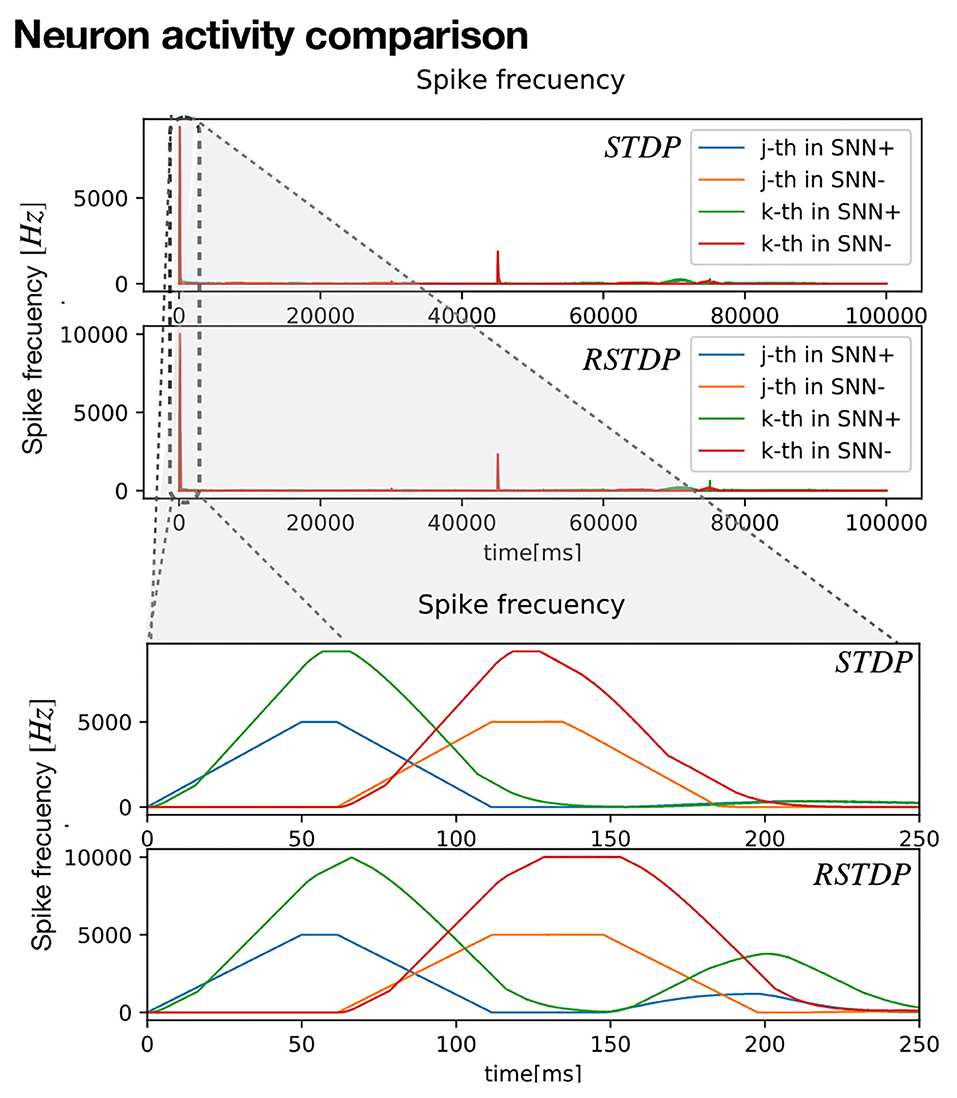
Figure 7. Neuron activity for 1-link controller pendulum. First, t = 100s of the entire control execution is shown, for SNN-STDP (Up) and SNN-RSTDP (down). A zoom at t = 0ms − 250ms is shown at the highest neuron activity.
4. Discussion
The utility of a neuromorphic controller operation for a 1-DOF robot capable of learning the changing dynamics has been experimentally demonstrated with results comparable with a standard control technique. The PID used for comparison is tuned using a pretty standard and popular procedure for industrial applications. It is an iterative process that intends to eliminate response oscillations based on select proper gains throughout multiple testing executions in the plant. The procedure ends when the responsible technician is pleased with the performance, making it as precise as its interpretation, and it has to be re-tuned each time the dynamics of the plant change.
Unlike the PID, our proposal eliminates the need for tuning procedures. Nonetheless, some issues have to be addressed. First, SNN parameters were selected to mimic biological brain systems, which can be modified to fit actual electrical circuit standards. For example, values of wmin and wmax were chosen arbitrarily, while they should be scaled to fit actual memristor conductance limit values.
A+, A−, which control LTD and LTP, play an important role in stability, as they control the learning rate of the system. Small values will result in slow convergence, while larger values will overshoot the output control signal. Value sth for SF encoding will determine its sensitivity against the input signal, setting the amount of neural activity (spikes) as the response. For decoding, sth determines output modification, as it has to be sufficiently large to scale the outgoing signal and sufficiently small to avoid overshoot and under-damping behavior. SF encoding also shows no neural activity for the SNN- stage for always increasing signals. Ic modules spiking frequency, as for higher values, output signal amplitude is affected too.
A stability analysis to determine proper LTD, LTP values, thresholds, and current inputs for encoding/decoding and learning rate values is needed. While it is a pending task, some challenges arise, as some system dynamics are not differentiable (LIF, SF models). Therefore, Lyapunov asymptotic stability analysis cannot be performed. However, some possible alternatives are proposing differentiable models of the neuron dynamics, defining the system on the frequency domain, or conducting Von Neumann stability studies.
On the other hand, noise then allows to update synaptic weights constantly, but the sensibility of the encoding is crucial, as for small sth values, signal variation produces redundant neural activity, generating an accumulative error for decoding. Our proposal effectively used neuron dynamics as a filter, in an open loop. A possible alternative to use or implement alongside would be to use the Moving-Window SF algorithm instead. Similar to SF, starting from an initial baseline and threshold values, the baseline is updated differently as an average input signal for a time window. This corresponds to a median filter.
As this scheme proposal tackles fully actuated 1-DOF robotic manipulators, its usage in N-DOF has to be studied. SNN structure might be usable in under-actuated systems, but the SNN architecture must be modified. Hyper-redundant manipulators present a similar problem, as flexible robotic arms can be considered like infinite DOF systems. An infinite neural structure generation is problematic. Therefore, modifications have to be proposed in the future.
5. Conclusion
A self-tuning SNN architecture for a 1-DOF manipulator robot arm is proposed, based on a typical control scheme. Numerical simulation shows the feasibility and, in some cases, outperforms PID performance. The architecture also shows self-tuning properties on changing dynamics. From the control theory point of view, a neural structure with similar PID performance is described. Nevertheless, stability analysis is still pending, describing the relationship between spiking activity, current injection, learning rate, and coding velocity. Besides, explainable neural networks are possible, considering control loop architectures. However, neuron models, synapses, and coding/decoding modules should be implemented in analog circuit counterparts to achieve real-time computing scenarios with efficient energy consumption.
Data Availability Statement
The datasets presented in this study can be found in online repositories. The name of the repository and accession number can be found below: Github, https://github.com/AlejandroJuarezLora/Frontiers-SNN.git.
Author Contributions
AJ-L proposed, developed, programmed the neural control code and conducted simulation runs, and wrote the first draft of the manuscript. VP-P and HS proposed modifications to the SNN architectures. ER-E reviewed the code required for the PID controller experiments. All authors contributed to the conception and design of the study and manuscript revision, read, and approved the submitted version.
Funding
The authors would like to thank the economic support of the projects SIP 20210124, 20221780, 20211657, 20220268, 20212044, 20221089, 20210788, 20220226, and COFAA and CONACYT FORDECYT-PRONACES 6005.
Conflict of Interest
The authors declare that the research was conducted in the absence of any commercial or financial relationships that could be construed as a potential conflict of interest.
The handling editor JD declared a shared affiliation with the authors at the time of review.
Publisher's Note
All claims expressed in this article are solely those of the authors and do not necessarily represent those of their affiliated organizations, or those of the publisher, the editors and the reviewers. Any product that may be evaluated in this article, or claim that may be made by its manufacturer, is not guaranteed or endorsed by the publisher.
Acknowledgments
The authors would like to thank the support provided by Instituto Politécnico Nacional, Secretaría de Investigación y Posgrado, Comisión de Operación y Fomento de Actividades Académicas, and CONACYT-México for the support to carry out this research.
References
Bing, Z., Baumann, I., Jiang, Z., Huang, K., Cai, C., and Knoll, A. (2019a). Supervised learning in snn via reward-modulated spike-timing-dependent plasticity for a target reaching vehicle. Front. Neurorobot. 13, 18. doi: 10.3389/fnbot.2019.00018
Bing, Z., Jiang, Z., Cheng, L., Cai, C., Huang, K., and Knoll, A. (2019b). “End to end learning of a multi-layered snn based on r-stdp for a target tracking snake-like robot,” in 2019 International Conference on Robotics and Automation (ICRA), 9645–9651.
Chen, X., Zhu, W., Dai, Y., and Ren, Q. (2020). “A bio-inspired spiking neural network for control of a 4-dof robotic arm,” in 2020 15th IEEE Conference on Industrial Electronics and Applications (ICIEA) (Kristiansand: IEEE), 616–621.
Craig, J. J. (1986). Introduction to Robotics: Mechanics and Control. Reading, MA: Addison-Wesley Publishing Co. Inc.
Dupeyroux, J. (2021). A toolbox for neuromorphic sensing in robotics. arXiv [Preprint]. Available online at: https://arxiv.org/abs/2103.02751
Framaux, N., and Gerstner, W. (2016). Neuromodulated spike-timing-dependent plasticity, and theory of three-factor learning rules. Front. Neural Circ. 9, 85. doi: 10.3389/fncir.2015.00085
Gerstner, W., Lehmann, M., Liakoni, V., Corneil, D., and Brea, J. (2018). Eligibility traces and plasticity on behavioral time scales: experimental support of NeoHebbian three-factor learning rules. Front. Neural Circ. 12, 53. doi: 10.3389/fncir.2018.00053
Guo, W., Fouda, M. E., Eltawil, A. M., and Salama, K. N. (2021). Neural coding in spiking neural networks: a comparative study for robust neuromorphic systems. Front. Neurosci. 15, 638474. doi: 10.3389/fnins.2021.638474
Hao, Y., Huang, X., Dong, M., and Xu, B. (2020). A biologically plausible supervised learning method for spiking neural networks using the symmetric stdp rule. Neural Netw. 121, 387–395. doi: 10.1016/j.neunet.2019.09.007
Hu, T., Lin, X., Wang, X., and Du, P. (2022). Supervised learning algorithm based on spike optimization mechanism for multilayer spiking neural networks. Int. J. Mach. Learn. Cybern. doi: 10.1007/s13042-021-01500-8
Izhikevich, E. (2004). Which model to use for cortical spiking neurons? IEEE Trans. Neural Netw. 15, 1063–1070. doi: 10.1109/TNN.2004.832719
Kasabov, N., Scott, N. M., Tu, E., Marks, S., Sengupta, N., Capecci, E., et al. (2016). Evolving spatio-temporal data machines based on the neucube neuromorphic framework: design methodology and selected applications. Neural Netw. 78, 1–14. doi: 10.1016/j.neunet.2015.09.011
Kendall, J. D., and Kumar, S. (2020). The building blocks of a brain-inspired computer. Appl. Phys. Rev. 7, 011305. doi: 10.1063/1.5129306
Kheradpisheh, S. R., and Masquelier, T. (2020). Temporal backpropagation for spiking neural networks with one spike per neuron. Int. J. Neural Syst. 30, 2050027. doi: 10.1142/S0129065720500276
Kim, H., Mahmoodi, M. R., Nili, H., and Strukov, D. B. (2021). 4k-memristor analog-grade passive crossbar circuit. Nat. Commun. 12, 5198. doi: 10.1038/s41467-021-25455-0
Lu, H., Liu, J., Luo, Y., Hua, Y., Qiu, S., and Huang, Y. (2021). An autonomous learning mobile robot using biological reward modulate stdp. Neurocomputing 458, 308–318. doi: 10.1016/j.neucom.2021.06.027
Lynch, K. (2017). Modern Robotics: Mechanics, Planning, and Control. Cambridge, United Kingdom; New York, NY: Cambridge University Press.
Mohemmed, A., Schliebs, S., Matsuda, S., and And Kasabov, N. (2012). Span: spike pattern association neuron for learning spatio-temporal spike patterns. Int. J. Neural Syst. 22, 1250012. doi: 10.1142/S0129065712500128
Morrison, A., Diesmann, M., and Gerstner, W. (2008). Phenomenological models of synaptic plasticity based on spike timing. Biol. Cybern. 98, 459–478. doi: 10.1007/s00422-008-0233-1
Petro, B., Kasabov, N., and Kiss, R. M. (2020). Selection and optimization of temporal spike encoding methods for spiking neural networks. IEEE Trans. Neural Netw. Learn. Syst. 31, 358–370. doi: 10.1109/TNNLS.2019.2906158
Saxena, V., Wu, X., Srivastava, I., and Zhu, K. (2018). Towards neuromorphic learning machines using emerging memory devices with brain-like energy efficiency. J. Low Power Electron. Appl. 8, 34. doi: 10.3390/jlpea8040034
Shi, C., Lu, J., Wang, Y., Li, P., and Tian, M. (2021). “Exploiting memristors for neuromorphic reinforcement learning,” in 2021 IEEE 3rd International Conference on Artificial Intelligence Circuits and Systems (AICAS) (Washington DC: IEEE), 1–4.
Spong, M. W., Hutchinson, S., and Vidyasagar, M. (2005). Robot Modeling and Control. Wiley. 146–189.
Taherkhani, A., Belatreche, A., Li, Y., Cosma, G., Maguire, L. P., and McGinnity, T. (2020). A review of learning in biologically plausible spiking neural networks. Neural Netw. 122, 253–272. doi: 10.1016/j.neunet.2019.09.036
Valadez-Godínez, S., Sossa, H., and Santiago-Montero, R. (2020). On the accuracy and computational cost of spiking neuron implementation. Neural Netw. 122, 196–217. doi: 10.1016/j.neunet.2019.09.026
Voelker, A. R., and Eliasmith, C. (2020). Programming Neuromorphics Using the Neural Engineering Framework. Singapore: Springer Singapore.
Yue, K., and Parker, A. C. (2019). “Analog neurons with dopamine-modulated stdp,” in 2019 IEEE Biomedical Circuits and Systems Conference (BioCAS) (Nara: IEEE), 1–4.
Zamarreño-Ramos, C., Camuñas-Mesa, L. A., Pérez-Carrasco, J. A., Masquelier, T., Serrano-Gotarredona, T., and Linares-Barranco, B. (2011). On spike-timing-dependent-plasticity, memristive devices, and building a self-learning visual cortex. Front. Neurosci. 5, 26. doi: 10.3389/fnins.2011.00026
Keywords: neuromorphic, robotics, reinforcement learning, STDP, reward modulation, control theory, applications
Citation: Juarez-Lora A, Ponce-Ponce VH, Sossa H and Rubio-Espino E (2022) R-STDP Spiking Neural Network Architecture for Motion Control on a Changing Friction Joint Robotic Arm. Front. Neurorobot. 16:904017. doi: 10.3389/fnbot.2022.904017
Received: 25 March 2022; Accepted: 14 April 2022;
Published: 18 May 2022.
Edited by:
Jose De Jesus Rubio, Instituto Politécnico Nacional (IPN), MexicoReviewed by:
Luis Arturo Soriano, Chapingo Autonomous University, MexicoGenaro Ochoa, Instituto Tecnológico Superior de Tierra Blanca, Mexico
Ricardo Balcazar, Technological Institute of Higher Studies of Coacalco (TESCO), Mexico
Copyright © 2022 Juarez-Lora, Ponce-Ponce, Sossa and Rubio-Espino. This is an open-access article distributed under the terms of the Creative Commons Attribution License (CC BY). The use, distribution or reproduction in other forums is permitted, provided the original author(s) and the copyright owner(s) are credited and that the original publication in this journal is cited, in accordance with accepted academic practice. No use, distribution or reproduction is permitted which does not comply with these terms.
*Correspondence: Alejandro Juarez-Lora, amp1YXJlemwyMDIwQGNpYy5pcG4ubXg=; Victor H. Ponce-Ponce, dnBvbmNlQGNpYy5pcG4ubXg=
 Alejandro Juarez-Lora
Alejandro Juarez-Lora Victor H. Ponce-Ponce
Victor H. Ponce-Ponce Humberto Sossa
Humberto Sossa Elsa Rubio-Espino
Elsa Rubio-Espino